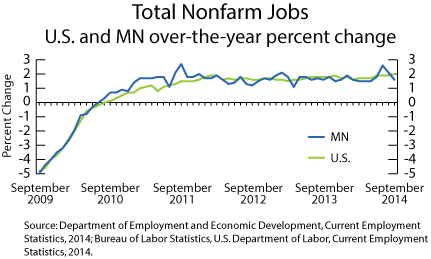by Nick Dobbins
October 2014
Monthly analysis is based on unadjusted employment data.
Employment was up slightly before seasonal adjustment in September, as the metro added 1,371 jobs (0.1 percent). The gain came largely from the public sector, as private employers lost 9,628 jobs (0.6 percent). Government employment, on the other hand, was up 10,999 (4.8 percent) on the month. This government employment increase was a common trait in all metros this month as schools ramped up hiring for fall classes. The biggest losses came in the Trade, Transportation, and Utilities supersector which shed 5,381 jobs (1.7 percent). For the year, the Twin Cities metro added 30,677 jobs overall (1.7 percent), with most of the increase coming from the private sector. The only supersectors to contract were Trade, Transportation, and Utilities (down 5,925, 1.9 percent) and Information (down 273, 0.7 percent). Notable annual expansions included Educational and Health Services (up 10,542, or 3.6 percent), Leisure and Hospitality (up 6,962, 4 percent), Manufacturing (up 8,156, 4.5 percent), and Professional and Business Services (up 7,246, 2.6 percent).
Employment increased in September as the metro added 923 jobs (0.7 percent). Gains among service providers (up 1,554 or 1.3 percent) overcame job losses in goods producers (down 631, 3.6 percent) for the month. Government employment led the way, with both State and Local government showing significant employment jumps (up 1,324 or 20.7 percent and 1,060 or 7.0 percent, respectively) as the fall semester got under way. On the flip side, the largest employment declines came in Leisure and Hospitality (down 645, 4.4 percent) and Mining, Logging, and Construction (down 519, 5.2 percent). Annually, Duluth employment has grown by 986 jobs (0.7 percent) with the largest increases coming in Educational and Health Services (up 679, 2.2 percent) and Mining, Logging, and Construction (387, 4.3 percent).
The Rochester MSA lost jobs in September as employment ticked down by 910 jobs (0.8 percent) from August estimates. Job losses were spread across a number of supersectors, with notable examples including Trade, Transportation, and Utilities (down 193, 1.2 percent), Leisure and Hospitality (down 323, 3.3 percent), and Educational and Health Services (down 282, 0.6 percent). The Government supersector showed the largest employment increase of the month, adding 106 jobs (1.0 percent). Annually, employment is up 1,446 (1.3 percent) in Rochester, with growth in every supersector save Mining, Logging, and Construction (down 166 or 4.2 percent) and Financial Activities (down 40, 1.5 percent).
Employment in the St. Cloud MSA continued to grow in September as the area added 540 jobs (0.5 percent) over August estimates. As was the case across the state, private sector employment dropped for the month (down 1,064 or 1.1 percent), but overall employment was buoyed by strong growth in Government employment (up 1,604, 11.8 percent) as the new school year started. For the year, St. Cloud added jobs as well, up 2,102 (2.0 percent) over September 2013. The largest annual gains came in Mining, Logging, and Construction which was up 846 (15.4 percent) while the steepest decline came in Government employment which was off by 352 (2.3 percent).
Employment jumped sharply in September, adding 1,723 jobs (3.2 percent) after growing by less than 100 in August estimates. Both private and public sector employment grew in Mankato, up 1,000 (2.2 percent) and 723 (8.9 percent), respectively. For the year, the metro area has added 1,853 jobs (3.4 percent) with goods producers and service providers both growing.
Employment was up sharply in September as the area added 2,176 jobs (1.6 percent) over August estimates. The monthly increase came thanks to the addition of 2,584 jobs (16.8 percent) in Government, as the private sector lost 408 jobs (0.3 percent) on the month. The Fargo-Moorhead metro also added jobs over the past year, with September estimates coming in at 4,060 (3.0 percent) higher than in 2013. However, the annual increase was almost entirely from growth in private sector employment. Mining, Logging, and Construction led the way with the addition of 1,854 jobs (20.9 percent) since September 2013.
Employment was also up significantly in the Grand Forks-East Grand Forks MSA. The metro area added 2,776 jobs (5.1 percent) on the strength of an additional 2,225 Government employees (18.6 percent), primarily in the Local Government sector. Annually, metro area employment remains up only slightly, with 507 more jobs (0.9 percent) than in September 2013. Over-the-year gains in Educational and Health Services, Mining, Logging, and Construction, and Trade, Transportation, and Utilities were partially balanced by losses in the Leisure and Hospitality and the Government super sectors.
